All the time, individuals who care about gardening want to find out how they can improve their tomato plants’ production and growth. One of these methods is employing Epsom salt, which has become popular among many gardeners today. The main objective of this guide is to give a detailed consideration to both novices and experienced agriculturalists concerning the usefulness of Epsom salt for tomatoes. We will check why it works; how it should be used and what it cannot do. Therefore at the end of this article you will know whether it would be worthy to include Epsom salt in your gardening routine or not.
How does Epsom Salt benefit Tomato Plants?
Magnesium sulphate, which is Epsom salts, is full of essential nutrients that are extremely beneficial to tomato plants. Magnesium helps in photosynthesis, thereby making plant(s) more efficient in converting sunlight into energy and thus stronger and healthier plants. Sulfate, on the other hand, supports the production of essential proteins and enzymes. By tackling potential magnesium deficiencies in soils, Epsom salt can help avert issues such as yellow leaves and reduced fruiting, hence yielding more vigorous-growing plants.
What nutrients does Epsom Salt provide?
Epsom salt contains two main elements: magnesium and sulfate. For instance, magnesium contributes to chlorophyll synthesis, a pigment crucial for photosynthesis and general plant welfare. Additionally, sulfate is important in the development of vital proteins and enzymes. These nutrients support robust growth and increase nutrient uptake by enhancing the quality of tomato produce.
How does Epsom Salt prevent Blossom End Rot?
Blossom end rot is a widespread problem with tomatoes, evidenced by dark sunken lesions at the blossom end of fruits. It often associates with calcium deficiency within soils as well as inconsistent watering practices. Although it does not contain calcium itself, through enhancing overall nutrient absorption capacity of the plant; Epsom salts can be helpful indirectly. Therefore, magnesium found in Epsom salt improves the uptake rate of calcium, which happens to be another important nutrient among many others required by tomato plants. Besides, it improves root functionality and strengthens cell walls; thus, resistance against stresses that cause blossom-end rot, such as droughts, is built up by the plant over time.
Thus this means that although epsom salts alone will not prevent blossom-end rot from occurring directly they do foster a healthier environment for growth thus mitigating risk associated with imbalances in nutritional supplies.
How can Epsom salt be used to address magnesium deficiency?
To avoid excess fertilizer application when using Epsom salt to correct magnesium deficiency in tomato plants, it is important to employ the right quantities. So you can begin by dissolving epsom salt in water at a rate of 1 tablespoon per gallon. It should then be applied as a soil drench every four weeks, taking care that it spreads around the root zone uniformly. As for foliar spray mix 1 tablespoon of Epsom salts with a gallon of water and spray directly onto the leaves every two weeks. This method allows for fast uptake and can quickly alleviate deficiency symptoms. Improvement must always be monitored, and therefore, the frequency of application is adjusted accordingly.
When and How Should I Apply Epsom Salt to My Tomato Plants?
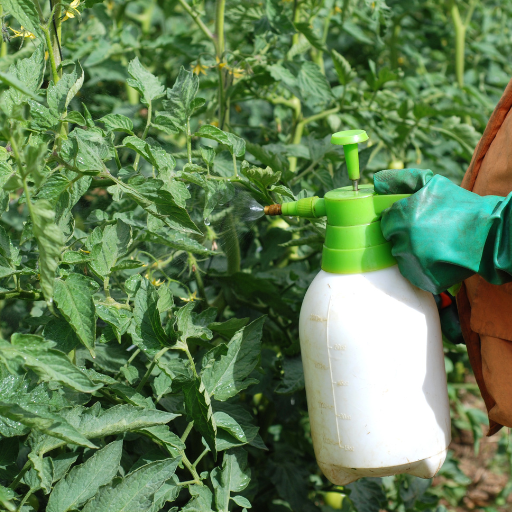
Using a gallon of water, dissolve a tablespoon of Epsom salt in it to make foliar spray. For tomatoes, roses and peppers which require high levels of magnesium, a decoction made by dissolving 1 tablespoon of Epsom salt in this amount of water could be sprayed on their leaves every two weeks. This solution immediately absorbs into the plants through the leaves ensuring timely corrections for any cases where the plant is not performing optimally because there is a lack of magnesium.
The Optimal Time to Use Epsom Salt as an Application
It can come in handy at the beginning of the season when young plants are still growing their roots. When transplanting or planting seedlings use one tablespoon of Epsom salt mixed with each hole you dig. The first dose provides adequate magnesium that encourages rapid growth.
In this period, applying Epsom salt helps supply flowering plants like tomatoes with enough magnesium needed for healthy blossoms. These instructions include spraying mature leaves every two weeks with a foliar spray mixture obtained by adding one tablespoonfuls of Epsom salt into one gallon of water. With such an operation being done on your crop, all necessary nutrients are quickly absorbed thus hastening blooming upon removing any deficiency in magnesium.
Magnesium levels have to be maintained throughout fruit set and development to ensure good quality and yield. Drop this ratio into 1 gallon of water for soil drench treatment applied once every four weeks around the base plant area then provide optimum amounts required by fruits while they ripen (Introduction). Regular monitoring and applications based on plant health is vital for continuous growth throughout a season.
Correct Dose: Tablespoons per Gallon
For most purposes in your garden, take between one and two tablespoons per gallon as recommended dosage for use with water (Introduction). It is also effective if you want to administer it directly onto the leaf or root system via either method above- although I usually prefer to mix it as a foliar spray since I can combine it with other beneficial nutrients. While 1 tablespoon per gallon may be appropriate in general, tomatoes and peppers may benefit from using more Epsom salt, at the higher end of this range, especially when flowering and fruiting.
Methods of Applications
Direct Method
With regard to this approach, put pockets of soil around the stem just below ground level. For some cases such as these – for instance when there is an immediate need for magnesium – use about one tablespoonfuls of Epsom salt per foot of plant height (Introduction). Moisture assist salts to dissolve into the soil properly hence reaching the roots.
Soil Techniques
Here you have to add water after dissolving Epsom salt into it for getting a drenched soil around your crop (Introduction). Use a mixture comprising one tablespoonfuls of Epsom salt into each gallon. Soil drench application every four weeks in growing times ensures that balanced nutrition and top-rated soil quality is maintained during crop production. This method suits crops like tomatoes and peppers due to their high magnesium demand.
Leaf Spray
It is when you dissolve the Epsom salt in water and spray it through the laves of the plant. The recommended proportion for this purpose is 1 tablespoon of Epsom salt per gallon of water. This method makes sure that magnesium gets absorbed at once by the leaves thereby enhancing immediate growth in plants. With reference to occasional high growth times such as flowering and fruiting periods, apply it after two weeks. Ensure that you make this application during early morning hours or late evenings to avoid burning of leaves and enhance total uptake.
These advantages are unique to every application approach and should be selected depending on your garden’s needs and conditions. By consistently controlling and adjusting the amount of Epsom salts, plant productivity can be greatly improved.
What Are the Signs of Magnesium Deficiency in Tomato Plants?
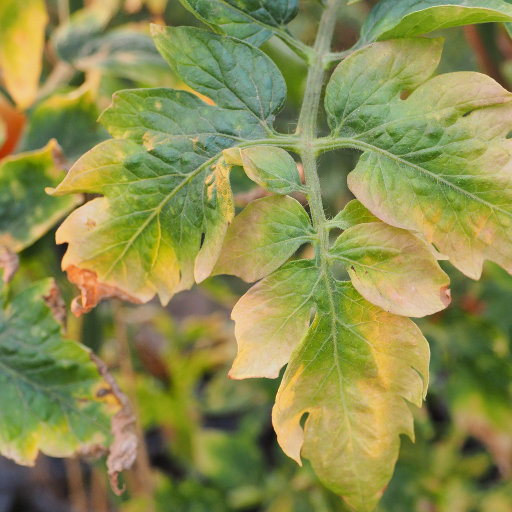
Several noticeable signs of the tomato plants’ magnesium deficiency can be seen. Such deficiency is marked by interveinal chlorosis as one of the major symptoms, with the yellowing of leaves occurring between veins while veins remain green. This usually starts with older leaves at the bottom of the plant. There may also be curling and increased brittleness in affected leaves. Furthermore, overall growth rate slows down, fewer flowers and fruits are produced by the plant as a result of magnesium deficiency that has grown worse over time. In extreme cases, fruit quality is compromised as tomatoes go greenback turning them less ripe from stem end. Regular monitoring and appropriate nutrient management can help to prevent or cure these symptoms.
Identification Of Yellowing Leaves And Symptoms
Yellow leaves on tomato plants due largely to insufficient magnesium can be observed among other things through yellowing between the leaf veins while veins themselves remain green; this is called interveinal chlorosis. Usually this occurs first on lower old leaves. Moreover, if it progresses further, it causes curving and brittleness in their stems which indicate a deficiency in magnesium too low in levels for proper cell functioning affecting plants’ health generally including stunted growth resulting into fewer flowers and fruits produced by such plants as a result of lack of enough magnesium hence reduced vegetative growth. Additionally, severe cases may lead to tomato showing greenback condition where area around stem stays green leading to uneven ripening thus making them poor quality fruits for sale or consumption. Plant monitoring and ensuring an optimal balance of nutrients will alleviate these issues.
Soil Testing To Confirm Nutrient Deficiency
To test soil for confirmation of nutrient shortage you should begin by collecting a representative soil sample from each section where tomatoes grow out there garden beds either using a clean spade or soil probe for multiple locations then mix them together to get an average sample size.Put this mixture inside a clean container , dry until all water evaporates then follow instructions given by the reliable soil test kit or send sample to professional laboratory. The levels of different nutrients in the soil including magnesium as a micronutrient and macronutrients like nitrogen, phosphorous and potassium are what these results will present forth. These results will provide an insight into any nutrient deficiencies that may exist in your soil for tomato farming purposes.
Using Epsom Salt To Remedy Magnesium Deficiency
1-2 tablespoons of Epsom salt can be dissolved in a gallon of water to correct magnesium deficiency in tomato plants using Epsom salt. Each fortnight you should pour it on the ground around your plants. It can also be sprayed on leaves especially from underneath as leaf surfaces are ideal for rapid absorption of minerals, including magnesium. By supplying missing magnesium Epsom salt helps restore chlorophyll production and overall wellness in the plant. Regular applications supported by monitoring its condition can significantly improve your plant’s growth and vitality.
Can Epsom Salt be used as a Fertilizer for Tomato Plants?
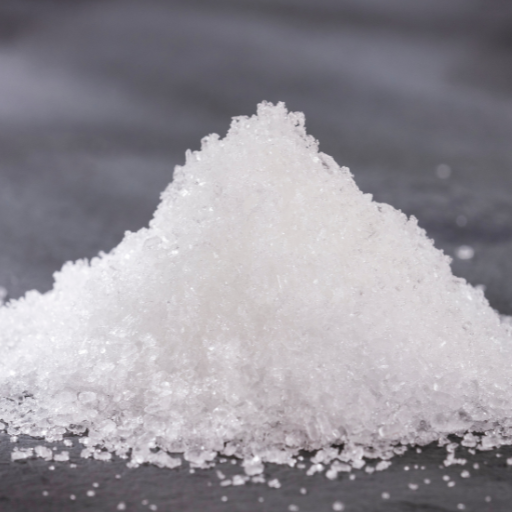
Magnesium sulfate, commonly known as Epsom salt, is not a complete fertilizer but can supply some extra magnesium and sulfur to tomato plants. Besides addressing specific nutrient deficiencies, the use of Epsom salt cannot replace the application of balanced fertilizers that contain nitrogen, phosphorus and potassium – crucial for optimum growth. It should be used in addition to other methods of soil fertilization so as to increase nutrients in the soil and support the general well-being of the tomatoes. For proper nutrition it is advisable to monitor on regular basis and do soil test.
Epsom Salt mixed with traditional fertilizers
To mix Epsom salt with traditional fertilizers simply follow these steps: prepare your traditional fertilizer according to the product’s instructions; ensure water-soluble types are fully dissolved in water; dissolve one or two tablespoons of Epsom salt in a gallon of water separately; combine the Epsom salt solution with prepared fertilizer solution into one mixture and stir thoroughly before applying them around your tomato plants’ base where it will get absorbed through its roots. This combination leaves behind essential plant feed while getting all the benefits from having magnesium and sulfur from Epsom salts. You may vary its quantity depending on your soil type, then always make sure you keep watering regularly after adding fertilizers.
Comparison between Epsom Salt and Calcium Nitrate
Epsom salt (magnesium sulphate) and calcium nitrate have different roles in providing nutrients to tomatoes. Mainly serving for chlorophyll synthesis which helps enzymes work well plus proteins building, Magnesium sulfate (epsomite), whereas calcium nitrate provides calcium necessary for strengthened cell walls along with nitrogen imperative for leafy vegetation.
Pros of using Epsom Salt:
- Magnesium Content: 10% by weight for photosynthesis purposes.
- Sulfur Content: 13% by weight – promotes amino acid formation.
Benefits derived from calcium nitrate:
- Calcium Content: 19% by weight; it is responsible for the reduction of blossom end rot.
- Nitrogen Content: 15.5% by weight, it causes leafy green growth
Therefore, while Epsom salt is good in raising magnesium and sulfur content, it has no nitrogen and phosphorous. Similarly calcium nitrate adds calcium and nitrogen but not magnesium or phosphorous. The use of both these supplements where necessary with traditional fertilizers can correct a wide range of tomato plant nutrient deficiencies. It is advisable to do soil testing to know what specific nutrients are required without over-fertilizing.
Is Epsom Salt Safe for all stages of Tomato Plant growth?
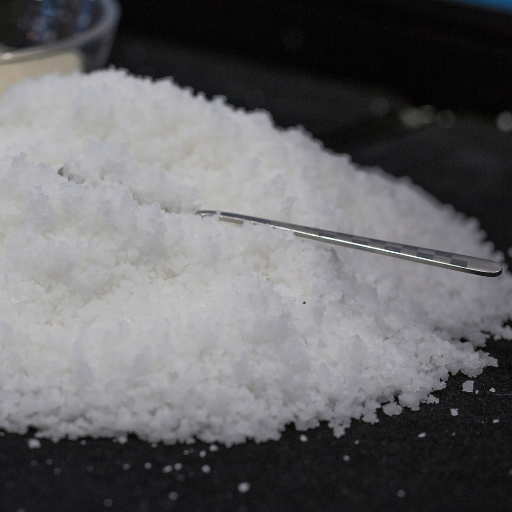
Epsom salt can be good for tomato plants at different stages of development, but it should be used sparingly. At the initial phases of tomato plant growth, Epsom salts, magnesium can promote seedling vigor and general health. However, a lot of magnesium is not advisable as this can destabilize the nutrients balance. In the course of time, occasional applications can help prevent magnesium deficiency in plants, especially if the soil lacks it. One must avoid over-application since too much Epsom salt may cause nutrient imbalances and hurt the plants. Always do soil testing and stick to recommended guidelines for using the same across all the growth phases of a tomato plant.
Treatment with Epsom Salt on germinating seeds
During germination, use Epsom salt to supply fast-absorbing magnesium that is essential for photosynthesis and the establishment of strong root systems. Before planting, you should dissolve one tablespoon of epsom salt into one gallon container of water and then soak your seeds to increase percentage germination as well as early seedling vigour. Alternatively, after sprouting, watering the seedlings with diluted Epsom salt solution will facilitate their early growth periods. Nonetheless, there must be caution against using much because excessive magnesium may hinder uptake of nutrients thereby destroying very young ones.
What is done to seedlings using Epsom Salt?
One way that you can treat your seedlings with epsom salt involves dissolving a tablespoon full in one gallon full jar or bucket containing water. As soon as they have their first set of real leaves use this mixture to irrigate them while they are still saplings. This ensures that they get a good dose of magnesium which will improve their overall development from infancy stages through maturity. It’s better to make this treatment once every month by pouring such solution on the ground near each plantlet without drenching them completely in magnesium ions beyond their tolerance level since this could give rise to nutrient imbalances in the soil, and affect plants badly. Additionally, incorporating soil tests to monitor nutrient levels and adjust as needed, will help to maintain balanced nutrient profiles for optimal seedling health.
Epsom Salt Usage during the growing season
Epsom salt can be applied to tomato plants during the growing season to enhance their health and productivity. Mix one tablespoon of Epsom salt with a gallon of water and use this solution to water the plants every two weeks. This maintains a steady supply of magnesium promoting healthy leaf growth while preventing problems like yellowing leaves or blossom-end rot. Foliar feeding is also an option; dissolve Epsom salt in water then spray it on leaves so that it can be easily absorbed through them. Continued application throughout the growing season helps in better absorption of vital nutrients such as nitrogen and phosphorous hence healthier plants producing more tomatoes. Keep watching out for any signs of excessive magnesium in your plants, adjusting application rates accordingly.
Can Epsom Salt Help Prevent Common Tomato Plant Problems?
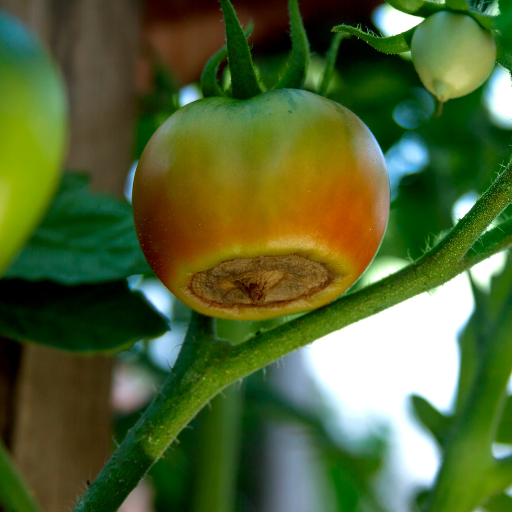
Certainly, Epson salt may be of use in averting a handful of ordinary troubles for tomato plants. It might reduce magnesium deficiency which normally shows through yellow leaves with green veins. Magnesium is usually required regularly to build up stronger and greener plants. Furthermore, it may also aid in combating other tomato difficulties such as blossom end rot by improving the plant’s calcium intake through better magnesium absorption although it is not a direct cure for calcium deficiency.Lastly, it can discourage particular ailments and pest invasions including spider mites and fungi invasion by making an unfavorable breeding ground against these conditions.
Preventing Blossom End Rot Using Epsom Salt
Blossom end rot is a common issue in tomato plants, often caused by a calcium deficiency but Epsom salt can play a supporting role in managing this problem. Although Epsom salt does not supply calcium directly, it helps enhance the uptake of essential minerals like sulphur and magnesium that can facilitate the absorption of soil calcium into the plant. By getting nutrients ratios right within the soil, this makes sure that calcium together with other important elements are taken up more efficiently hence minimizing chances of suffering from blossom end rot. Regular applications of Epsom salts along with proper watering and soil management techniques can help produce healthier tomato plants less affected by this condition.
Improving Germination and Early Seedling Health
Epson salts have been found to be useful during germination period as well as early seedling health. To develop strong cell walls and vigorous growth, Epson salts provide necessary magnesium and sulfur supplies. Epsom salt usage sparingly could improve seed germination rates moderately as well as induce roots that were solid enough to support healthy plant development after planting.Rather than using many chemicals or fertilizers to add trace elements to your starting soil just mix some water with Epsom salts before soaking your seeds here so they will get off to a good start.Salts should not be used excessively, as they may cause nutrient imbalances.
Reference sources
- National Garden Bureau (ngb.org)
- Source: Epsom Salts for Tomatoes? An Expert Weighs In
- Expert advice on diluting Epsom salt and applying it to tomato plants either as a drench to the roots or sprayed onto the plant foliage.
- Epic Gardening
- Source: Is Epsom Salt Good or Bad For Tomato Plants?
- Provides insights into the benefits of Epsom salts for tomato plants, particularly in situations where magnesium deficiency is an issue.
- GrowVeg
- Source: Fix Yellow Leaves on Tomato Plants Using Epsom Salts
- Offers guidance on resolving magnesium deficiency in tomato plants using Epsom salts, emphasizing its effectiveness in addressing yellow leaves on tomato plants.
Frequently Asked Questions (FAQs)
Q: What is Epsom salt and how can it help in growing tomatoes?
A: Epsom salt, also known as magnesium sulfate, is a garden supplement that can improve the magnesium in the soil, which is an important nutrient for tomato plants. Adding magnesium helps in the uptake of other micronutrients and is part of the chlorophyll molecule, which is essential for photosynthesis.
Q: How should I add Epsom salt to my vegetable garden?
A: To add Epsom salt directly to your vegetable garden, mix one cup of Epsom salt into the soil before planting tomatoes. Alternatively, you can dissolve it in water and use a spray bottle to apply it to the leaves every two weeks for optimal absorption of nutrients.
Q: How much Epsom salt should I use for my tomato plants?
A: For planting tomatoes, mix one cup of Epsom salt into the soil over time. During the growing season, you can also use a spray bottle to apply a solution made from one tablespoon of Epsom salt dissolved in a gallon of water. Spray this solution on the leaves every two weeks.
Q: Can Epsom salt help with deficiency symptoms in tomato plants?
A: Yes, Epsom salt can improve deficiency symptoms in tomato plants, such as yellowing leaves and poor fruit development. This is because tomatoes need magnesium as part of their nutrient balance to produce fruit and maintain healthy foliage.
Q: Is it safe to add Epsom salt directly to the soil around my tomato plants?
A: Yes, it is generally safe to add Epsom salt directly to the soil. Just ensure you do not overdo it, as an excess can lead to imbalances in the soil and potentially affect the uptake of other micronutrients.
Q: How does Epsom salt compare to commercial tomato fertilizer?
A: Epsom salt provides magnesium, which is an important nutrient often lacking in commercial tomato fertilizers. While commercial fertilizers provide a balance of nutrients, adding Epsom salt specifically addresses magnesium deficiencies, improving the overall health and productivity of tomato plants.
Q: Can Epsom salt help in pest control for tomato plants?
A: Epsom salt is not a pesticide, but it can help strengthen the plants, making them less susceptible to pests. For direct pest control, gardeners commonly use neem oil to protect tomato plants.
Q: How does Epsom salt affect seed starting for tomatoes?
A: For seed starting, Epsom salt can be beneficial in providing the necessary magnesium to young seedlings. Adding a diluted solution of Epsom salt during the initial watering can help ensure strong, healthy growth from the beginning.
Q: Should I be concerned about the balance of nutrients when using Epsom salt?
A: While Epsom salt helps add magnesium, it’s crucial to maintain the overall balance of nutrients in the soil. Regularly testing your soil and using a well-rounded tomato fertilizer can help ensure your plants need all necessary nutrients for optimal growth and fruit production.






